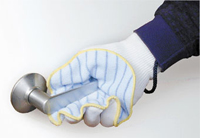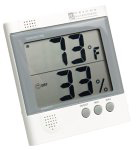|
|

|

Dirty Humidifiers Can be a Danger to Your Lungs: How to Make Sure Your Humidifiers are Truly Clean
by SixWise.com
|
Humidifiers
can be a saving grace to dry skin, lips and noses during the winter heating
season when moisture is scarce. Too little humidity in your home can lead
to not only dry, scratchy throats and skin, but it can also negatively
affect your home environment by causing static electricity, peeling wallpaper
and cracks in furniture, floors, cabinets and paint.
But
humidifiers, which work by releasing water vapor into the air, can also
be breeding grounds for bacteria and fungi -- both of which can travel,
via the water vapor, into your home and lungs.
Studies
by both the Environmental Protection Agency (EPA) and the Consumer Product
Safety Commission (CPSC) have shown that ultrasonic and impeller (or "cool
mist") humidifiers are capable of transporting the potentially toxic
mist, which can include microorganisms and minerals.
The
concern is so great that the U.S. Consumer Product Safety Commission (CPSC)
has alerted consumers that dirty room humidifiers -- the portable variety
-- can be serious health hazards.
|
 |

Humidifiers are great for helping
you avoid dry throats and dry
skin that looks like this, especially
during winter months. But if they're
not kept thoroughly clean they can
harbor bacteria and fungi that may
harm your lungs!
|
According
to the CPSC, breathing in dirty mist can lead to lung problems ranging from
flu-like symptoms to serious infection. People
with allergies or asthma, along with the elderly, young children and those
with lung diseases, are at a particularly high risk and may have increased
symptoms.
How
to Determine if YOUR Humidifier is Dirty
Any
type of film or scum appearing on the water surface, sides or bottom of
tank or motor parts is a sure sign that your humidifier tank is harboring
bacteria or fungi. In addition:
- If
your tank contains a crusty deposit or scale, which form when minerals
from the water collect on the tank, it is a prime surface for bacteria
and fungi to grow.
- The
white dust that sometimes appears on furniture and surfaces surrounding
the humidifier, which is composed of minerals from the water, may contain
tiny particles that can be inhaled.
Reduce
Your Risk by Keeping Your Humidifier Clean
According
to Kristin Holmze, a spokeswoman for the American Lung Association, "The
most common mistake people make with humidifiers is not cleaning them
correctly or not cleaning them at all."
|
|
The
following tips, compiled from information from the EPA and the CPSC, will
help to keep your humidifier clean and reduce your risk of associated
health problems.
- Change
the water in the humidifier tank daily, if possible
- Clean
the tank thoroughly every third day according to the manufacturer's
instructions, but be careful when using chemical cleansers. The cleansers
can also be inhaled if not rinsed properly. This is why cleansing your
tank with PerfectClean's
All-Purpose Terry Cloths or the Scrub
and Clean Reversible Glove is so ideal. They're made of 100%
safe ultramicrofibers that are only 3 microns in size, which is
even smaller than many bacteria. These
ultramicrofibers are by far the most effective cleaning material available.
They pick up anything in their path, down to those contaminants that
cannot be seen with the naked eye, and no harmful chemical cleansers
are necessary!
- If
you decide to use a cleanser, use water with a 3% solution of hydrogen
peroxide.
- To
eliminate mineral scale buildup and the release of "white dust"
use bottled distilled or demineralized water (tap water contains more
minerals).
- Use
demineralization cartridges or filters if they are recommended for your
humidifier.
- Clean,
and thoroughly dry, your unit before storing it for the summer. Also
clean it before its first use in the winter.
- Don't
let water stand in the tank for extended periods of time (such as while
you're on vacation).
- If
you experience respiratory symptoms that you believe are related to
your humidifier, stop using it immediately.
|
 |

The Scrub and Clean Reversible
Glove is ideal for cleaning those
hard-to-reach humidifier tanks.
For the special introductory price
of just $8.95 it:
- Eliminates
any hand-grip
strain (the wiper is on your
hand, so there is no need to
grasp it like a traditional rag)
- Is
a remarkably fast and
efficient way to clean
surfaces with curves and
edges that can be difficult
with other wipers.
- Is
commonly used over 100
times before requiring
replacement, so it's an
extremely convenient AND
cost-efficient way to clean!
Simply wash after use and
they're as good as new!
- Can
be used dry or with water for the most effective "deep clean"
you'll find anywhere!
|
|

Use a hygrometer like this one
with an easy-to-read display to
measure the humidity level in
your home. Levels exceeding 50
percent can lead to the growth of
biological pollutants that can
aggravate allergic symptoms
and asthma.
Read More Now
|
 |
Another concern? Too much humidity in your home can lead to the growth of biological pollutants, which can cause allergic reactions and asthma symptoms. For this reason, do not humidify your home to levels exceeding 50 percent humidity.
You can use a hygrometer -- like the recommended thermo-hygrometer with a jumbo easy-to-read display -- to measure humidity levels in your home. Some humidifiers also contain built-in humidistats that can be adjusted to a specific moisture level.
If you follow these tips, you should be able to experience the benefits of a home humidifier -- some much-needed moisture for your skin and throat in the dry days of winter -- without having to sacrifice your respiratory health in exchange.
- Remove mold from walls and ceilings before painting or staining.
|
- Clean
shower curtains well and replace them as needed
- Vacuum
regularly using a vacuum with a high-efficiency filter like a HEPA
filter (High Efficiency Particulate Air filter). Empty the dirt bag
when it gets to be half full or less.
- Control
dust by washing bedding often and in hot water to kill dust mites.
Use the commercial-grade PerfectClean
Flexible Duster that can be bent into a wide variety of shapes
to clean all those areas that, up until now, were impossible for you
(let alone any other duster) to reach, but are some of the most common
locations of dirt, dust, pet hair, lint and potentially harmful microscopic
contaminants!
In
the event that you decide to move to a new home, be sure to inspect
it thoroughly so you don't inherit a new set of pollutant problems when
you move in.
Using
common sense to keep your home free of excess moisture and keeping all
surfaces clean will go a long way toward improving the indoor air quality
of your home and reducing your exposure to harmful biological contaminants.
|
To get more information about this and other highly important topics, sign up for your free subscription to our weekly SixWise.com "Be Safe, Live Long & Prosper" e-newsletter.
With every issue of the free SixWise.com newsletter, you’ll get access to the insights, products, services, and more that can truly improve your well-being, peace of mind, and therefore your life!
|
|
|
|